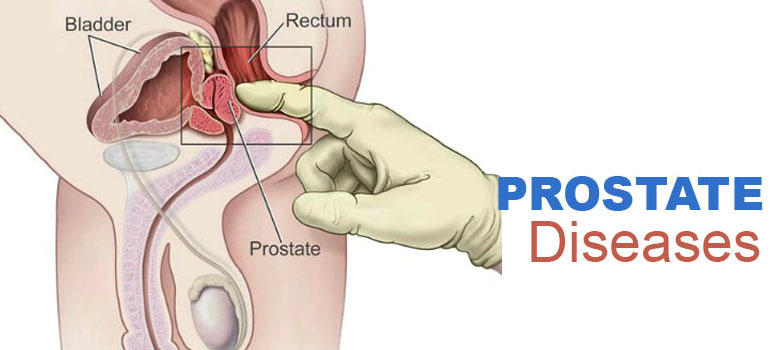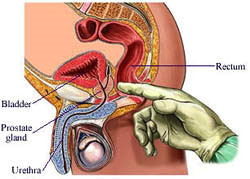
The prostate is a walnut-sized gland that forms part of the male reproductive system. The gland is made up of two lobes or regions enclosed by an outer layer of tissue. It is located in front of the rectum and just below the urinary bladder which is the storage organ for urine. The prostate gland surrounds the urethra, the canal through which urine passes out of the body.
Benign enlargement of the prostate or benign prostatic hyperplasia (BPH) is a non cancerous growth of the prostate gland. It is considered more as an aging disorder rather than a disease.
The scientists do not know all the prostate's functions. One of its main roles, though, is to squeeze fluid into the urethra as sperm move through during sexual climax. This fluid, which helps make up semen, energizes the sperm and makes the vaginal canal less acidic.
Benign Prostatic Hyperplasia (BPH) is not considered a disease but it is an aging process. As the age advances and hair turns grey, the prostate gland enlarges around the same time. The prostate gland continues to grow during most of a man's life. However, it does not cause symptoms before 40 years of age. After 50 years of age, a man begins to complain of symptoms due to Benign Prostatic Hyperplasia (BPH). As the prostate enlarges, the layer of tissue surrounding it stops it from expanding, causing the gland to press against the urethra like a clamp on a garden hose. The bladder wall becomes thicker and irritable. The bladder begins to contract even when it contains small amounts of urine, causing more frequent urination. Eventually, the bladder weakens and loses the ability to empty itself, so some of the urine remains in the bladder. The narrowing of the urethra and partial emptying of the bladder cause many of the problems associated with Benign Prostatic Hyperplasia (BPH).
Most men will experience occasional impotence, usually resulting from stress, tiredness, anxiety or excessive alcohol or other drug consumption. Worrying about impotence may then set the scene for a more persistent problem due to "fear of failure" known as performance anxiety.

Benign Prostatic Hyperplasis (BPH) is not considered a disease but it is an aging process. As the age advances and hair turns grey, the prostate gland enlarges aroung the same time. The prostate gland continues to grow during most of a man's life. However, it does not cause symptoms before 40 years of age. After 50 years of age, a man begins to complain of symptoms due to Benign Prostatic Hyperplasis (BPH). As the prostate enlarges, the layer of tissue surrounding it stops it from expanding, causing the gland to press against the urethra like a clamp on a garden hose. The bladder wall becomes thicker and irritable. The bladder begins to contract even when it contains small amounts of urine, causing more frequent urination. Eventually, the bladder weakens and loses the ability to empty itself, so some of the urine remains in the bladder. The narrowing of the urethra and partial emptying of the bladder cause many of the problems associated with Benign Prostatic Hyperplasis (BPH)Most men will experience occasional impotence, usually resulting from stress, tiredness, anxiety or excessive alcohol or other drug consumption. Worrying about impotence may then set the scene for a more persistent problem due to "fear of failure" known as performance anxiety.
Many people feel uncomfortable talking about the prostate, since the gland plays a role in both sex and urination. Still, prostate enlargement is as common a part of aging as gray hair. As life expectancy rises, so does the occurrence of Benign Prostatic Hyperplasis (BPH). In the United States in 2000, there were 4.5 million visits to physicians for Benign Prostatic Hyperplasis (BPH).
Obstructive Symptoms are:
Irritative Symptoms are:
There has been constant research to find a newer drug for the treatment of BPH. These drugs are either aimed at shrinking the prostate gland and/ or prevent the growth of the prostate or facilitate the passage of urine by relaxing the obstructed passage which is been caused by BPH.
FDA has approved a few drugs. The FDA also approved the drugs terazosin (Hytrin) in 1993, doxazosin (Cardura) in 1995, tamsulosin (Flomax) in 1997, and alfuzosin (Uroxatral) in 2003, Alfuzosin in 2003 and Silodosin in 2008 for the treatment of BPH. All four drugs act by relaxing the smooth muscle of the prostate and bladder neck to improve urine flow and to reduce bladder outlet obstruction. The four drugs belong to the class known as alpha blockers. Terazosin and doxazosin were developed first to treat high blood pressure. Tamsulosin and alfuzosin were developed specifically to treat BPH.
Though the medical treatment may give relief in some selected cases it is important not to prolong the medication just to escape surgery.
Because drug treatment is not effective in all cases, researchers in recent years have developed a number of procedures that relieve BPH symptoms but are less invasive than conventional surgery.
Most of the urologists will recommend removal of the enlarged part of the prostate which is symptomatic. The gold standard for the surgical treatment for Benign prostate hyperplasia (BPH) is Trans Urethral Resection of Prostate (TURP). This treatment is offered to the patients with signs and symptoms of outflow obstruction / LUTS secondary to Benign prostate hyperplasia (BPH).
In this surgery, only the enlarged tissue that is causing obstruction to the urethra is removed. The rest of the peripheral tissue which is outside the capsule are left intact. This usually helps them in relieving the obstructions and other symptoms of Benign prostate hyperplasia (BPH).
In the few cases when a transurethral procedure cannot be used, open surgery, which requires an external incision, may be used. Open surgery is often done when the gland is greatly enlarged, when there are complicating factors, or when the bladder has been damaged and needs to be repaired. The location of the enlargement within the gland and the patient's general health helps the surgeon decide which of the three open procedures to use.
With all the open procedures, anaesthesia is given and an incision is made. Once the surgeon reaches the prostate capsule, he or she scoops out the enlarged tissue from inside the gland.
Holmium lasers are used to enucleate obstructing prostate lobe. The doctor passes the laser fibre through the urethra into the prostate using a cystoscope and then delivers holmium laser. The laser energy cuts and coagulates the prostate tissue. Hence there is no bleeding As with Trans Urethral Resection of Prostate (TURP), laser surgery requires anaesthesia and a hospital stay.
Urethral Resection of Prostate (TURP) is that laser surgery causes little blood loss. Laser surgery also allows for a quicker recovery time. But laser surgery may not be effective on larger prostates. The long-term effectiveness of laser surgery is not known.